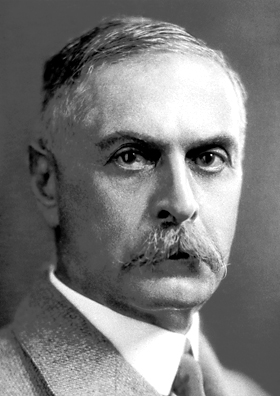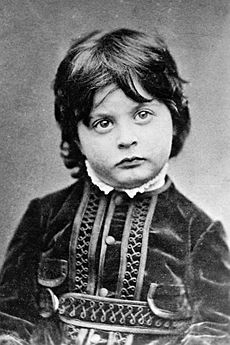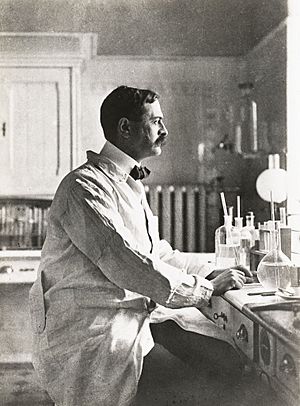Karl Landsteiner facts for kids
Quick facts for kids
Karl Landsteiner
|
|
|---|---|
 |
|
| Born | 14 June 1868 Baden bei Wien, Austria-Hungary
|
| Died | 26 June 1943 (aged 75) New York City, US
|
| Citizenship |
|
| Alma mater | University of Vienna (MD, 1891) |
| Known for | Research of blood group system, discovery of Rh factor, discovery of poliovirus |
| Awards |
|
| Scientific career | |
| Fields |
|
| Institutions |
|
| Signature | |
Karl Landsteiner (born June 14, 1868 – died June 26, 1943) was an important scientist. He was a biologist, doctor, and expert in immunity. He was born in Austria but later moved to New York in 1923. There, he worked at the Rockefeller Institute.
Landsteiner made huge discoveries that changed medicine. In 1900, he found the main blood groups. This led to the modern way we classify blood. In 1937, with Alexander S. Wiener, he found the Rhesus factor (Rh factor). This discovery made blood transfusions much safer for patients.
He also helped discover the polio virus in 1909. He worked with Constantin Levaditi and Erwin Popper on this. For his amazing work, he won the Nobel Prize in Physiology or Medicine in 1930. Many people call him the "father of transfusion medicine."
Contents
Early Life and Education
Karl Landsteiner was born into a family in Austria. His father, Leopold Landsteiner, was a well-known journalist. Sadly, his father died when Karl was only six years old. Karl became very close to his mother, Fanny.
After finishing high school in Vienna, he decided to study medicine. He went to the University of Vienna. In 1891, he finished his medical degree. Even as a student, he wrote about how different diets affect blood.
From 1891 to 1893, Landsteiner studied chemistry. He learned from famous chemists like Emil Fischer in Würzburg. He also studied in Munich and Zürich. During this time, he published several scientific papers. Some of these were with his professors.
Discovering the Polio Virus
After his chemistry studies, Landsteiner returned to Vienna. He became an assistant at the Hygienic Institute. Here, he focused on how the body's immune system works. He also studied what antibodies are.
From 1897 to 1908, he worked at the University of Vienna. He wrote 75 papers on topics like serology (study of blood serum), bacteriology (study of bacteria), and virology (study of viruses). He also performed many autopsies, which are medical examinations after death.
During this time, he made a very important discovery. With Erwin Popper, he found out that poliomyelitis (polio) was caused by a virus. They were able to isolate the polio virus. This discovery was key to fighting polio. Because of this, he was honored in the Polio Hall of Fame in 1958.
Understanding Blood Groups
In 1900, Landsteiner made his most famous discovery. He noticed that when blood from two different people mixed, it sometimes clumped together. This clumping is called agglutination. In 1901, he figured out that this happened because of substances in the blood serum.
He then identified three main blood groups: A, B, and O. He originally called the O group "C." He also found that blood transfusions worked best when people had the same blood group. If the groups were different, the blood cells could be destroyed.
Thanks to his findings, the first successful blood transfusion happened in 1907. It was performed by Reuben Ottenberg in New York.
Today, we know that people with blood group AB can receive red blood cells from any other blood group. They are called universal recipients. People with blood group O-negative can donate red blood cells to all other groups. They are known as universal donors. This is because O-negative blood has no special markers (antigens) that would cause a reaction.
In 1930, Landsteiner received the Nobel Prize in Physiology or Medicine for his work on blood groups. His discoveries truly made him the father of transfusion medicine.
Work in the Netherlands and the United States
After World War I, Austria faced tough economic times. Landsteiner found it hard to continue his research there. So, he moved to the Netherlands. He worked at a hospital in The Hague. He also took a job at a small factory to earn more money. He published several papers during this time.
However, the working conditions were still difficult. So, in 1923, he accepted an invitation to move to New York. He joined the Rockefeller Institute, a famous research center.
Throughout the 1920s, Landsteiner continued his research. He studied how the immune system works and what causes allergies. In 1927, he discovered even more blood groups: M, N, and P. These discoveries helped refine blood typing even further. Later, these new blood types were used in paternity cases to determine who a child's father was.
Awards and Honors
Karl Landsteiner received many awards for his groundbreaking work. Besides the Nobel Prize in Physiology or Medicine, he was elected to the National Academy of Sciences in 1932. He also became a member of the American Philosophical Society in 1935.
In 1937, he received the Cameron Prize for Therapeutics of the University of Edinburgh. He was also made a Foreign Member of the Royal Society in 1941. After he passed away, he was given the Lasker-DeBakey Clinical Medical Research Award in 1946.
To honor his legacy, World Blood Donor Day is celebrated every year on June 14. This is the day he was born. In 2016, Google also celebrated his 148th birthday with a special drawing called a "doodle."
Personal Life
In 1890, Karl Landsteiner converted to the Catholic Church. In 1916, he married Leopoldine Helene Wlasto. She was a Greek Orthodox woman who also converted to Catholicism.
Images for kids
See also
 In Spanish: Karl Landsteiner para niños
In Spanish: Karl Landsteiner para niños





